2003 DODGE RAM stop start
[x] Cancel search: stop startPage 2159 of 2895
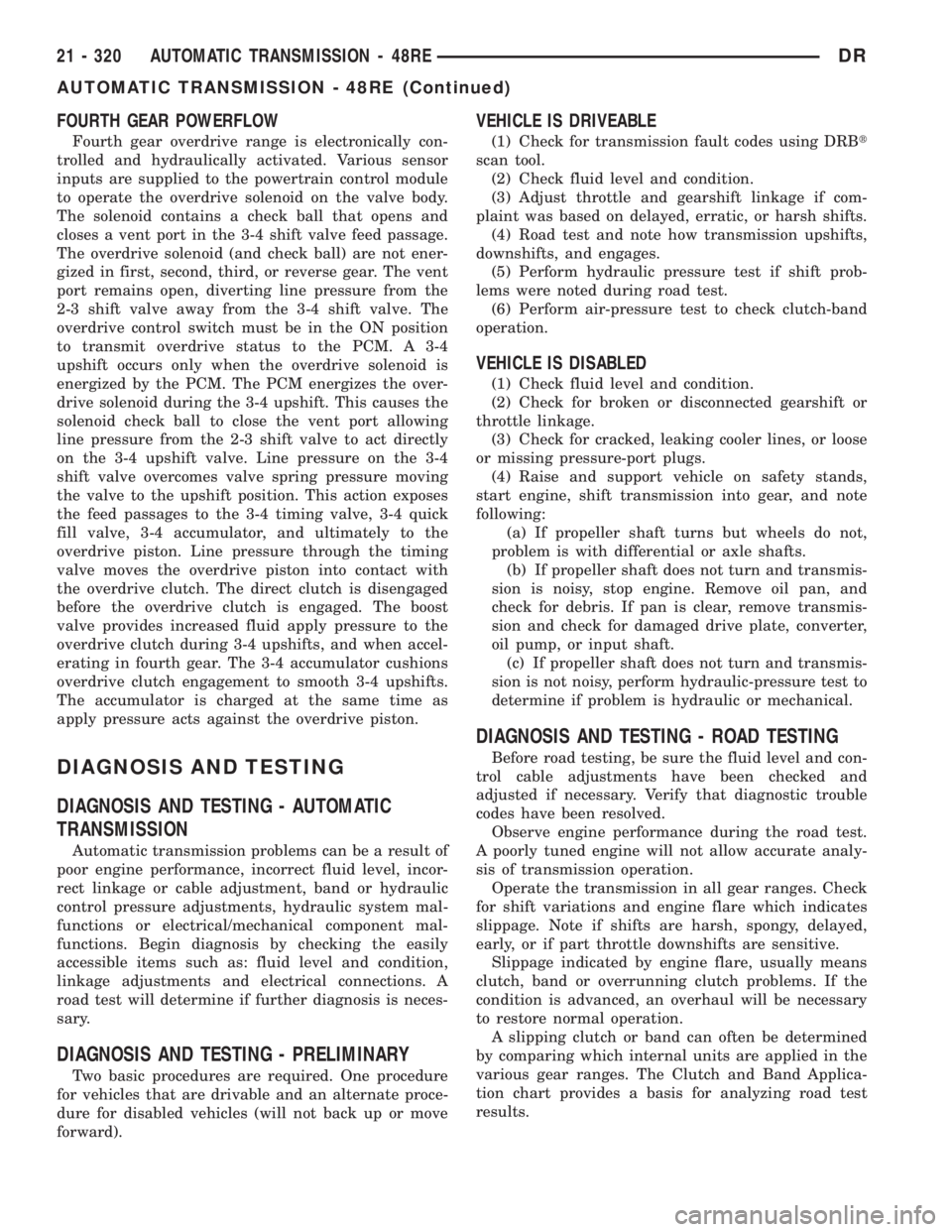
FOURTH GEAR POWERFLOW
Fourth gear overdrive range is electronically con-
trolled and hydraulically activated. Various sensor
inputs are supplied to the powertrain control module
to operate the overdrive solenoid on the valve body.
The solenoid contains a check ball that opens and
closes a vent port in the 3-4 shift valve feed passage.
The overdrive solenoid (and check ball) are not ener-
gized in first, second, third, or reverse gear. The vent
port remains open, diverting line pressure from the
2-3 shift valve away from the 3-4 shift valve. The
overdrive control switch must be in the ON position
to transmit overdrive status to the PCM. A 3-4
upshift occurs only when the overdrive solenoid is
energized by the PCM. The PCM energizes the over-
drive solenoid during the 3-4 upshift. This causes the
solenoid check ball to close the vent port allowing
line pressure from the 2-3 shift valve to act directly
on the 3-4 upshift valve. Line pressure on the 3-4
shift valve overcomes valve spring pressure moving
the valve to the upshift position. This action exposes
the feed passages to the 3-4 timing valve, 3-4 quick
fill valve, 3-4 accumulator, and ultimately to the
overdrive piston. Line pressure through the timing
valve moves the overdrive piston into contact with
the overdrive clutch. The direct clutch is disengaged
before the overdrive clutch is engaged. The boost
valve provides increased fluid apply pressure to the
overdrive clutch during 3-4 upshifts, and when accel-
erating in fourth gear. The 3-4 accumulator cushions
overdrive clutch engagement to smooth 3-4 upshifts.
The accumulator is charged at the same time as
apply pressure acts against the overdrive piston.
DIAGNOSIS AND TESTING
DIAGNOSIS AND TESTING - AUTOMATIC
TRANSMISSION
Automatic transmission problems can be a result of
poor engine performance, incorrect fluid level, incor-
rect linkage or cable adjustment, band or hydraulic
control pressure adjustments, hydraulic system mal-
functions or electrical/mechanical component mal-
functions. Begin diagnosis by checking the easily
accessible items such as: fluid level and condition,
linkage adjustments and electrical connections. A
road test will determine if further diagnosis is neces-
sary.
DIAGNOSIS AND TESTING - PRELIMINARY
Two basic procedures are required. One procedure
for vehicles that are drivable and an alternate proce-
dure for disabled vehicles (will not back up or move
forward).
VEHICLE IS DRIVEABLE
(1) Check for transmission fault codes using DRBt
scan tool.
(2) Check fluid level and condition.
(3) Adjust throttle and gearshift linkage if com-
plaint was based on delayed, erratic, or harsh shifts.
(4) Road test and note how transmission upshifts,
downshifts, and engages.
(5) Perform hydraulic pressure test if shift prob-
lems were noted during road test.
(6) Perform air-pressure test to check clutch-band
operation.
VEHICLE IS DISABLED
(1) Check fluid level and condition.
(2) Check for broken or disconnected gearshift or
throttle linkage.
(3) Check for cracked, leaking cooler lines, or loose
or missing pressure-port plugs.
(4) Raise and support vehicle on safety stands,
start engine, shift transmission into gear, and note
following:
(a) If propeller shaft turns but wheels do not,
problem is with differential or axle shafts.
(b) If propeller shaft does not turn and transmis-
sion is noisy, stop engine. Remove oil pan, and
check for debris. If pan is clear, remove transmis-
sion and check for damaged drive plate, converter,
oil pump, or input shaft.
(c) If propeller shaft does not turn and transmis-
sion is not noisy, perform hydraulic-pressure test to
determine if problem is hydraulic or mechanical.
DIAGNOSIS AND TESTING - ROAD TESTING
Before road testing, be sure the fluid level and con-
trol cable adjustments have been checked and
adjusted if necessary. Verify that diagnostic trouble
codes have been resolved.
Observe engine performance during the road test.
A poorly tuned engine will not allow accurate analy-
sis of transmission operation.
Operate the transmission in all gear ranges. Check
for shift variations and engine flare which indicates
slippage. Note if shifts are harsh, spongy, delayed,
early, or if part throttle downshifts are sensitive.
Slippage indicated by engine flare, usually means
clutch, band or overrunning clutch problems. If the
condition is advanced, an overhaul will be necessary
to restore normal operation.
A slipping clutch or band can often be determined
by comparing which internal units are applied in the
various gear ranges. The Clutch and Band Applica-
tion chart provides a basis for analyzing road test
results.
21 - 320 AUTOMATIC TRANSMISSION - 48REDR
AUTOMATIC TRANSMISSION - 48RE (Continued)
Page 2330 of 2895
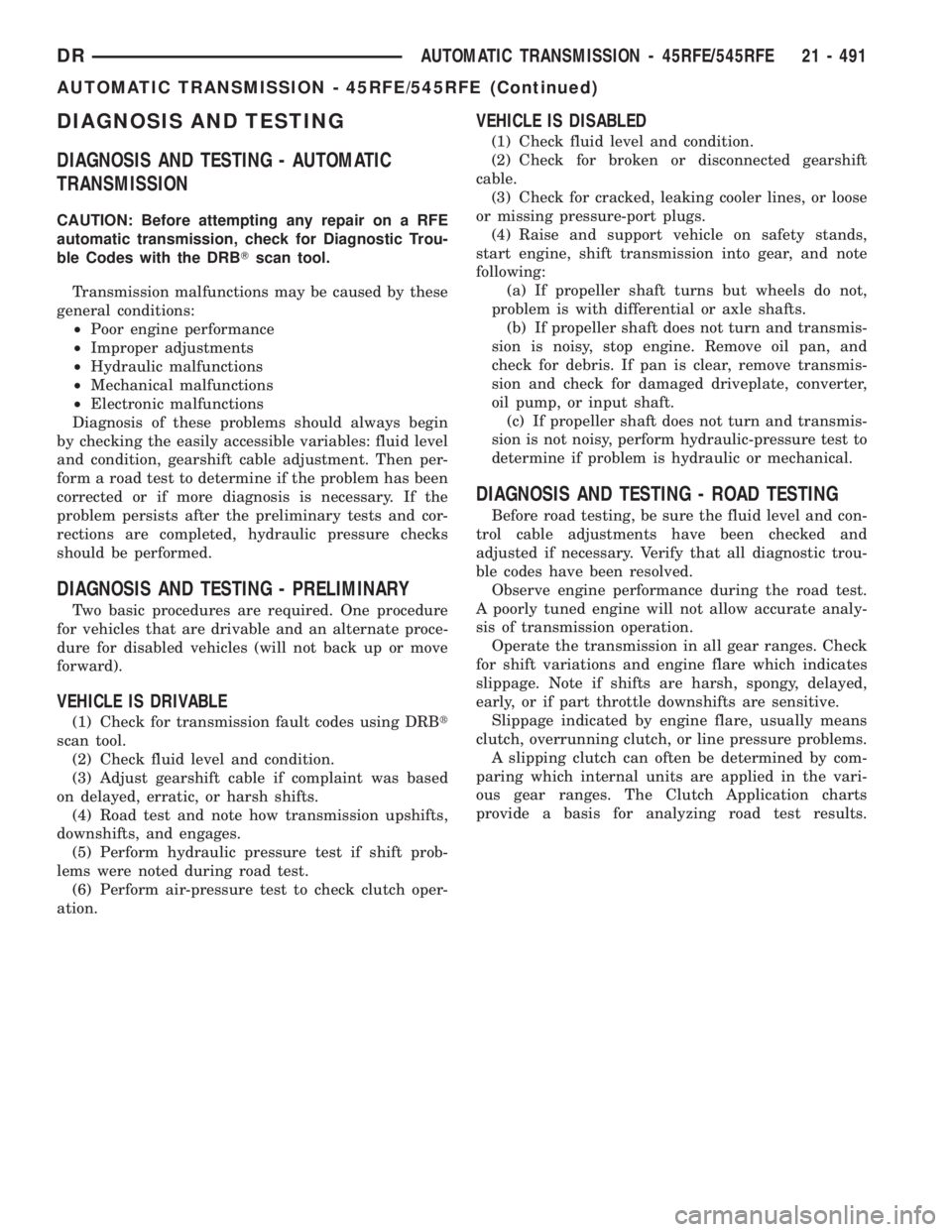
DIAGNOSIS AND TESTING
DIAGNOSIS AND TESTING - AUTOMATIC
TRANSMISSION
CAUTION: Before attempting any repair on a RFE
automatic transmission, check for Diagnostic Trou-
ble Codes with the DRBTscan tool.
Transmission malfunctions may be caused by these
general conditions:
²Poor engine performance
²Improper adjustments
²Hydraulic malfunctions
²Mechanical malfunctions
²Electronic malfunctions
Diagnosis of these problems should always begin
by checking the easily accessible variables: fluid level
and condition, gearshift cable adjustment. Then per-
form a road test to determine if the problem has been
corrected or if more diagnosis is necessary. If the
problem persists after the preliminary tests and cor-
rections are completed, hydraulic pressure checks
should be performed.
DIAGNOSIS AND TESTING - PRELIMINARY
Two basic procedures are required. One procedure
for vehicles that are drivable and an alternate proce-
dure for disabled vehicles (will not back up or move
forward).
VEHICLE IS DRIVABLE
(1) Check for transmission fault codes using DRBt
scan tool.
(2) Check fluid level and condition.
(3) Adjust gearshift cable if complaint was based
on delayed, erratic, or harsh shifts.
(4) Road test and note how transmission upshifts,
downshifts, and engages.
(5) Perform hydraulic pressure test if shift prob-
lems were noted during road test.
(6) Perform air-pressure test to check clutch oper-
ation.
VEHICLE IS DISABLED
(1) Check fluid level and condition.
(2) Check for broken or disconnected gearshift
cable.
(3) Check for cracked, leaking cooler lines, or loose
or missing pressure-port plugs.
(4) Raise and support vehicle on safety stands,
start engine, shift transmission into gear, and note
following:
(a) If propeller shaft turns but wheels do not,
problem is with differential or axle shafts.
(b) If propeller shaft does not turn and transmis-
sion is noisy, stop engine. Remove oil pan, and
check for debris. If pan is clear, remove transmis-
sion and check for damaged driveplate, converter,
oil pump, or input shaft.
(c) If propeller shaft does not turn and transmis-
sion is not noisy, perform hydraulic-pressure test to
determine if problem is hydraulic or mechanical.
DIAGNOSIS AND TESTING - ROAD TESTING
Before road testing, be sure the fluid level and con-
trol cable adjustments have been checked and
adjusted if necessary. Verify that all diagnostic trou-
ble codes have been resolved.
Observe engine performance during the road test.
A poorly tuned engine will not allow accurate analy-
sis of transmission operation.
Operate the transmission in all gear ranges. Check
for shift variations and engine flare which indicates
slippage. Note if shifts are harsh, spongy, delayed,
early, or if part throttle downshifts are sensitive.
Slippage indicated by engine flare, usually means
clutch, overrunning clutch, or line pressure problems.
A slipping clutch can often be determined by com-
paring which internal units are applied in the vari-
ous gear ranges. The Clutch Application charts
provide a basis for analyzing road test results.
DRAUTOMATIC TRANSMISSION - 45RFE/545RFE 21 - 491
AUTOMATIC TRANSMISSION - 45RFE/545RFE (Continued)
Page 2577 of 2895

VISUAL INSPECTION BEFORE WATER LEAK TESTS
Verify that floor and body plugs are in place, body
drains are clear, and body components are properly
aligned and sealed. If component alignment or seal-
ing is necessary, refer to the appropriate section of
this group for proper procedures.
WATER LEAK TESTS
WARNING: DO NOT USE ELECTRIC SHOP LIGHTS
OR TOOLS IN WATER TEST AREA. PERSONAL
INJURY CAN RESULT.
When the conditions causing a water leak have
been determined, simulate the conditions as closely
as possible.
²If a leak occurs with the vehicle parked in a
steady light rain, flood the leak area with an open-
ended garden hose.
²If a leak occurs while driving at highway speeds
in a steady rain, test the leak area with a reasonable
velocity stream or fan spray of water. Direct the
spray in a direction comparable to actual conditions.
²If a leak occurs when the vehicle is parked on an
incline, hoist the end or side of the vehicle to simu-
late this condition. This method can be used when
the leak occurs when the vehicle accelerates, stops or
turns. If the leak occurs on acceleration, hoist the
front of the vehicle. If the leak occurs when braking,
hoist the back of the vehicle. If the leak occurs on left
turns, hoist the left side of the vehicle. If the leak
occurs on right turns, hoist the right side of the vehi-
cle. For hoisting recommendations (Refer to LUBRI-
CATION & MAINTENANCE/HOISTING -
STANDARD PROCEDURE).
WATER LEAK DETECTION
To detect a water leak point-of-entry, do a water
test and watch for water tracks or droplets forming
on the inside of the vehicle. If necessary, remove inte-
rior trim covers or panels to gain visual access to the
leak area. If the hose cannot be positioned without
being held, have someone help do the water test.
Some water leaks must be tested for a considerable
length of time to become apparent. When a leak
appears, find the highest point of the water track or
drop. The highest point usually will show the point of
entry. After leak point has been found, repair the
leak and water test to verify that the leak has
stopped.
Locating the entry point of water that is leaking
into a cavity between panels can be difficult. The
trapped water may splash or run from the cavity,
often at a distance from the entry point. Most water
leaks of this type become apparent after accelerating,
stopping, turning, or when on an incline.MIRROR INSPECTION METHOD
When a leak point area is visually obstructed, use
a suitable mirror to gain visual access. A mirror can
also be used to deflect light to a limited-access area
to assist in locating a leak point.
BRIGHT LIGHT LEAK TEST METHOD
Some water leaks in the luggage compartment can
be detected without water testing. Position the vehi-
cle in a brightly lit area. From inside the darkened
luggage compartment inspect around seals and body
seams. If necessary, have a helper direct a drop light
over the suspected leak areas around the luggage
compartment. If light is visible through a normally
sealed location, water could enter through the open-
ing.
PRESSURIZED LEAK TEST METHOD
When a water leak into the passenger compart-
ment cannot be detected by water testing, pressurize
the passenger compartment and soap test exterior of
the vehicle. To pressurize the passenger compart-
ment, close all doors and windows, start engine, and
set heater control to high blower in HEAT position. If
engine can not be started, connect a charger to the
battery to ensure adequate voltage to the blower.
With interior pressurized, apply dish detergent solu-
tion to suspected leak area on the exterior of the
vehicle. Apply detergent solution with spray device or
soft bristle brush. If soap bubbles occur at a body
seam, joint, seal or gasket, the leak entry point could
be at that location.
DIAGNOSIS AND TESTING - WIND NOISE
Wind noise is the result of most air leaks. Air leaks
can be caused by poor sealing, improper body compo-
nent alignment, body seam porosity, or missing plugs
in the engine compartment or door hinge pillar areas.
All body sealing points should be airtight in normal
driving conditions. Moving sealing surfaces will not
always seal airtight under all conditions. At times,
side glass or door seals will allow wind noise to be
noticed in the passenger compartment during high
cross winds. Over compensating on door or glass
adjustments to stop wind noise that occurs under
severe conditions can cause premature seal wear and
excessive closing or latching effort. After a repair pro-
cedure has been performed, test vehicle to verify
noise has stopped before returning vehicle to use.
VISUAL INSPECTION BEFORE TESTS
Verify that floor and body plugs are in place and
body components are aligned and sealed. If compo-
nent alignment or sealing is necessary, refer to the
appropriate section of this group for proper proce-
dures.
23 - 2 BODYDR
BODY (Continued)
Page 2832 of 2895
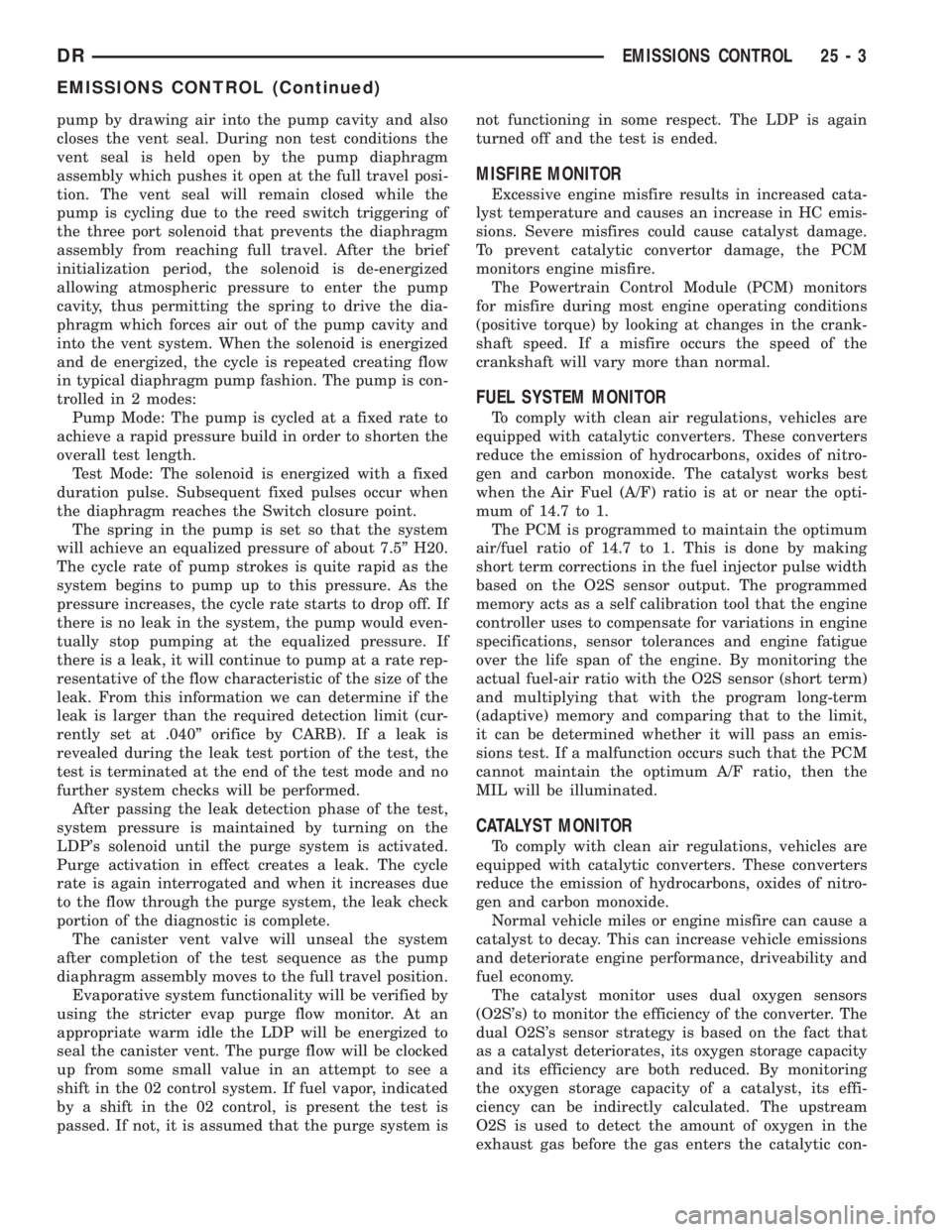
pump by drawing air into the pump cavity and also
closes the vent seal. During non test conditions the
vent seal is held open by the pump diaphragm
assembly which pushes it open at the full travel posi-
tion. The vent seal will remain closed while the
pump is cycling due to the reed switch triggering of
the three port solenoid that prevents the diaphragm
assembly from reaching full travel. After the brief
initialization period, the solenoid is de-energized
allowing atmospheric pressure to enter the pump
cavity, thus permitting the spring to drive the dia-
phragm which forces air out of the pump cavity and
into the vent system. When the solenoid is energized
and de energized, the cycle is repeated creating flow
in typical diaphragm pump fashion. The pump is con-
trolled in 2 modes:
Pump Mode: The pump is cycled at a fixed rate to
achieve a rapid pressure build in order to shorten the
overall test length.
Test Mode: The solenoid is energized with a fixed
duration pulse. Subsequent fixed pulses occur when
the diaphragm reaches the Switch closure point.
The spring in the pump is set so that the system
will achieve an equalized pressure of about 7.5º H20.
The cycle rate of pump strokes is quite rapid as the
system begins to pump up to this pressure. As the
pressure increases, the cycle rate starts to drop off. If
there is no leak in the system, the pump would even-
tually stop pumping at the equalized pressure. If
there is a leak, it will continue to pump at a rate rep-
resentative of the flow characteristic of the size of the
leak. From this information we can determine if the
leak is larger than the required detection limit (cur-
rently set at .040º orifice by CARB). If a leak is
revealed during the leak test portion of the test, the
test is terminated at the end of the test mode and no
further system checks will be performed.
After passing the leak detection phase of the test,
system pressure is maintained by turning on the
LDP's solenoid until the purge system is activated.
Purge activation in effect creates a leak. The cycle
rate is again interrogated and when it increases due
to the flow through the purge system, the leak check
portion of the diagnostic is complete.
The canister vent valve will unseal the system
after completion of the test sequence as the pump
diaphragm assembly moves to the full travel position.
Evaporative system functionality will be verified by
using the stricter evap purge flow monitor. At an
appropriate warm idle the LDP will be energized to
seal the canister vent. The purge flow will be clocked
up from some small value in an attempt to see a
shift in the 02 control system. If fuel vapor, indicated
by a shift in the 02 control, is present the test is
passed. If not, it is assumed that the purge system isnot functioning in some respect. The LDP is again
turned off and the test is ended.
MISFIRE MONITOR
Excessive engine misfire results in increased cata-
lyst temperature and causes an increase in HC emis-
sions. Severe misfires could cause catalyst damage.
To prevent catalytic convertor damage, the PCM
monitors engine misfire.
The Powertrain Control Module (PCM) monitors
for misfire during most engine operating conditions
(positive torque) by looking at changes in the crank-
shaft speed. If a misfire occurs the speed of the
crankshaft will vary more than normal.
FUEL SYSTEM MONITOR
To comply with clean air regulations, vehicles are
equipped with catalytic converters. These converters
reduce the emission of hydrocarbons, oxides of nitro-
gen and carbon monoxide. The catalyst works best
when the Air Fuel (A/F) ratio is at or near the opti-
mum of 14.7 to 1.
The PCM is programmed to maintain the optimum
air/fuel ratio of 14.7 to 1. This is done by making
short term corrections in the fuel injector pulse width
based on the O2S sensor output. The programmed
memory acts as a self calibration tool that the engine
controller uses to compensate for variations in engine
specifications, sensor tolerances and engine fatigue
over the life span of the engine. By monitoring the
actual fuel-air ratio with the O2S sensor (short term)
and multiplying that with the program long-term
(adaptive) memory and comparing that to the limit,
it can be determined whether it will pass an emis-
sions test. If a malfunction occurs such that the PCM
cannot maintain the optimum A/F ratio, then the
MIL will be illuminated.
CATALYST MONITOR
To comply with clean air regulations, vehicles are
equipped with catalytic converters. These converters
reduce the emission of hydrocarbons, oxides of nitro-
gen and carbon monoxide.
Normal vehicle miles or engine misfire can cause a
catalyst to decay. This can increase vehicle emissions
and deteriorate engine performance, driveability and
fuel economy.
The catalyst monitor uses dual oxygen sensors
(O2S's) to monitor the efficiency of the converter. The
dual O2S's sensor strategy is based on the fact that
as a catalyst deteriorates, its oxygen storage capacity
and its efficiency are both reduced. By monitoring
the oxygen storage capacity of a catalyst, its effi-
ciency can be indirectly calculated. The upstream
O2S is used to detect the amount of oxygen in the
exhaust gas before the gas enters the catalytic con-
DREMISSIONS CONTROL 25 - 3
EMISSIONS CONTROL (Continued)
Page 2833 of 2895
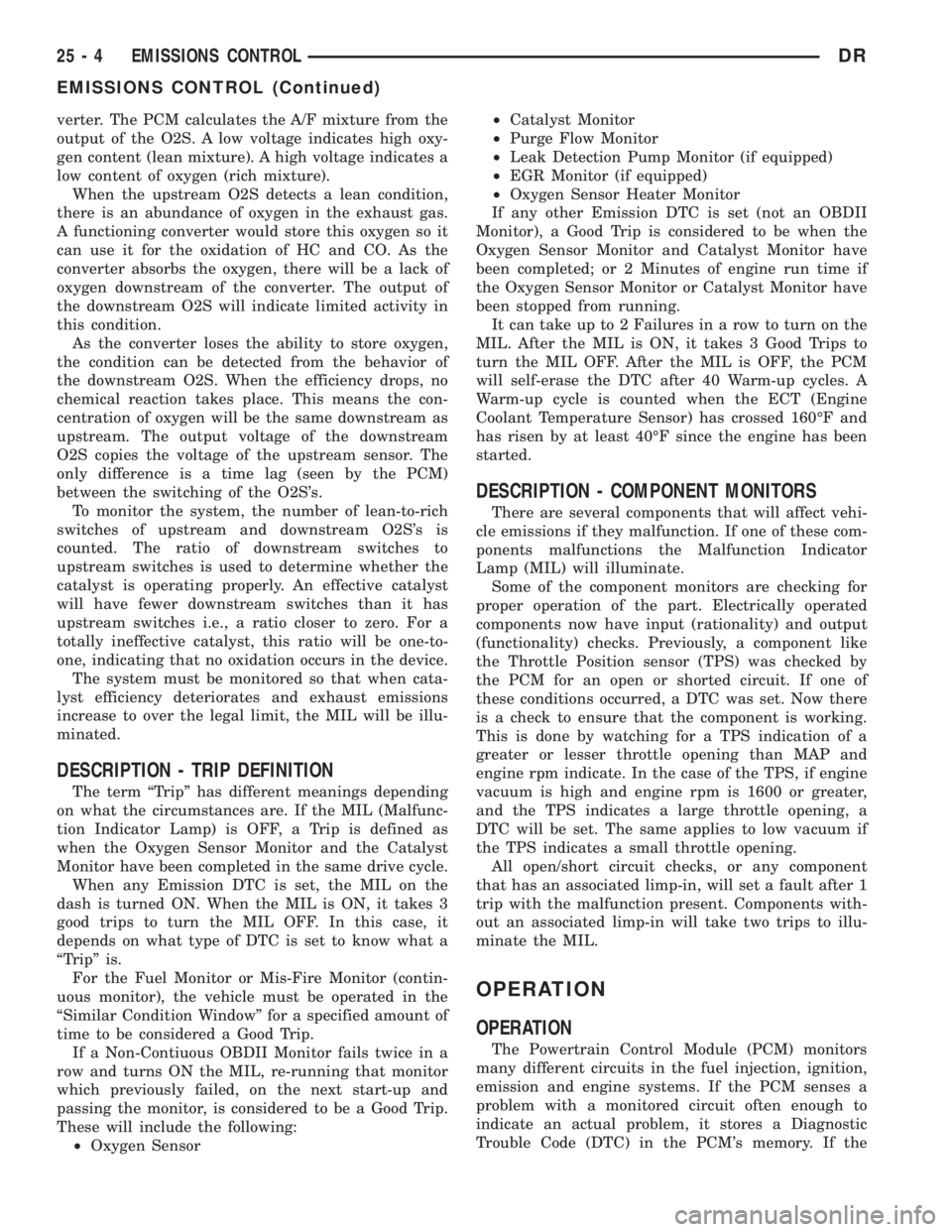
verter. The PCM calculates the A/F mixture from the
output of the O2S. A low voltage indicates high oxy-
gen content (lean mixture). A high voltage indicates a
low content of oxygen (rich mixture).
When the upstream O2S detects a lean condition,
there is an abundance of oxygen in the exhaust gas.
A functioning converter would store this oxygen so it
can use it for the oxidation of HC and CO. As the
converter absorbs the oxygen, there will be a lack of
oxygen downstream of the converter. The output of
the downstream O2S will indicate limited activity in
this condition.
As the converter loses the ability to store oxygen,
the condition can be detected from the behavior of
the downstream O2S. When the efficiency drops, no
chemical reaction takes place. This means the con-
centration of oxygen will be the same downstream as
upstream. The output voltage of the downstream
O2S copies the voltage of the upstream sensor. The
only difference is a time lag (seen by the PCM)
between the switching of the O2S's.
To monitor the system, the number of lean-to-rich
switches of upstream and downstream O2S's is
counted. The ratio of downstream switches to
upstream switches is used to determine whether the
catalyst is operating properly. An effective catalyst
will have fewer downstream switches than it has
upstream switches i.e., a ratio closer to zero. For a
totally ineffective catalyst, this ratio will be one-to-
one, indicating that no oxidation occurs in the device.
The system must be monitored so that when cata-
lyst efficiency deteriorates and exhaust emissions
increase to over the legal limit, the MIL will be illu-
minated.
DESCRIPTION - TRIP DEFINITION
The term ªTripº has different meanings depending
on what the circumstances are. If the MIL (Malfunc-
tion Indicator Lamp) is OFF, a Trip is defined as
when the Oxygen Sensor Monitor and the Catalyst
Monitor have been completed in the same drive cycle.
When any Emission DTC is set, the MIL on the
dash is turned ON. When the MIL is ON, it takes 3
good trips to turn the MIL OFF. In this case, it
depends on what type of DTC is set to know what a
ªTripº is.
For the Fuel Monitor or Mis-Fire Monitor (contin-
uous monitor), the vehicle must be operated in the
ªSimilar Condition Windowº for a specified amount of
time to be considered a Good Trip.
If a Non-Contiuous OBDII Monitor fails twice in a
row and turns ON the MIL, re-running that monitor
which previously failed, on the next start-up and
passing the monitor, is considered to be a Good Trip.
These will include the following:
²Oxygen Sensor²Catalyst Monitor
²Purge Flow Monitor
²Leak Detection Pump Monitor (if equipped)
²EGR Monitor (if equipped)
²Oxygen Sensor Heater Monitor
If any other Emission DTC is set (not an OBDII
Monitor), a Good Trip is considered to be when the
Oxygen Sensor Monitor and Catalyst Monitor have
been completed; or 2 Minutes of engine run time if
the Oxygen Sensor Monitor or Catalyst Monitor have
been stopped from running.
It can take up to 2 Failures in a row to turn on the
MIL. After the MIL is ON, it takes 3 Good Trips to
turn the MIL OFF. After the MIL is OFF, the PCM
will self-erase the DTC after 40 Warm-up cycles. A
Warm-up cycle is counted when the ECT (Engine
Coolant Temperature Sensor) has crossed 160ÉF and
has risen by at least 40ÉF since the engine has been
started.
DESCRIPTION - COMPONENT MONITORS
There are several components that will affect vehi-
cle emissions if they malfunction. If one of these com-
ponents malfunctions the Malfunction Indicator
Lamp (MIL) will illuminate.
Some of the component monitors are checking for
proper operation of the part. Electrically operated
components now have input (rationality) and output
(functionality) checks. Previously, a component like
the Throttle Position sensor (TPS) was checked by
the PCM for an open or shorted circuit. If one of
these conditions occurred, a DTC was set. Now there
is a check to ensure that the component is working.
This is done by watching for a TPS indication of a
greater or lesser throttle opening than MAP and
engine rpm indicate. In the case of the TPS, if engine
vacuum is high and engine rpm is 1600 or greater,
and the TPS indicates a large throttle opening, a
DTC will be set. The same applies to low vacuum if
the TPS indicates a small throttle opening.
All open/short circuit checks, or any component
that has an associated limp-in, will set a fault after 1
trip with the malfunction present. Components with-
out an associated limp-in will take two trips to illu-
minate the MIL.
OPERATION
OPERATION
The Powertrain Control Module (PCM) monitors
many different circuits in the fuel injection, ignition,
emission and engine systems. If the PCM senses a
problem with a monitored circuit often enough to
indicate an actual problem, it stores a Diagnostic
Trouble Code (DTC) in the PCM's memory. If the
25 - 4 EMISSIONS CONTROLDR
EMISSIONS CONTROL (Continued)
Page 2836 of 2895
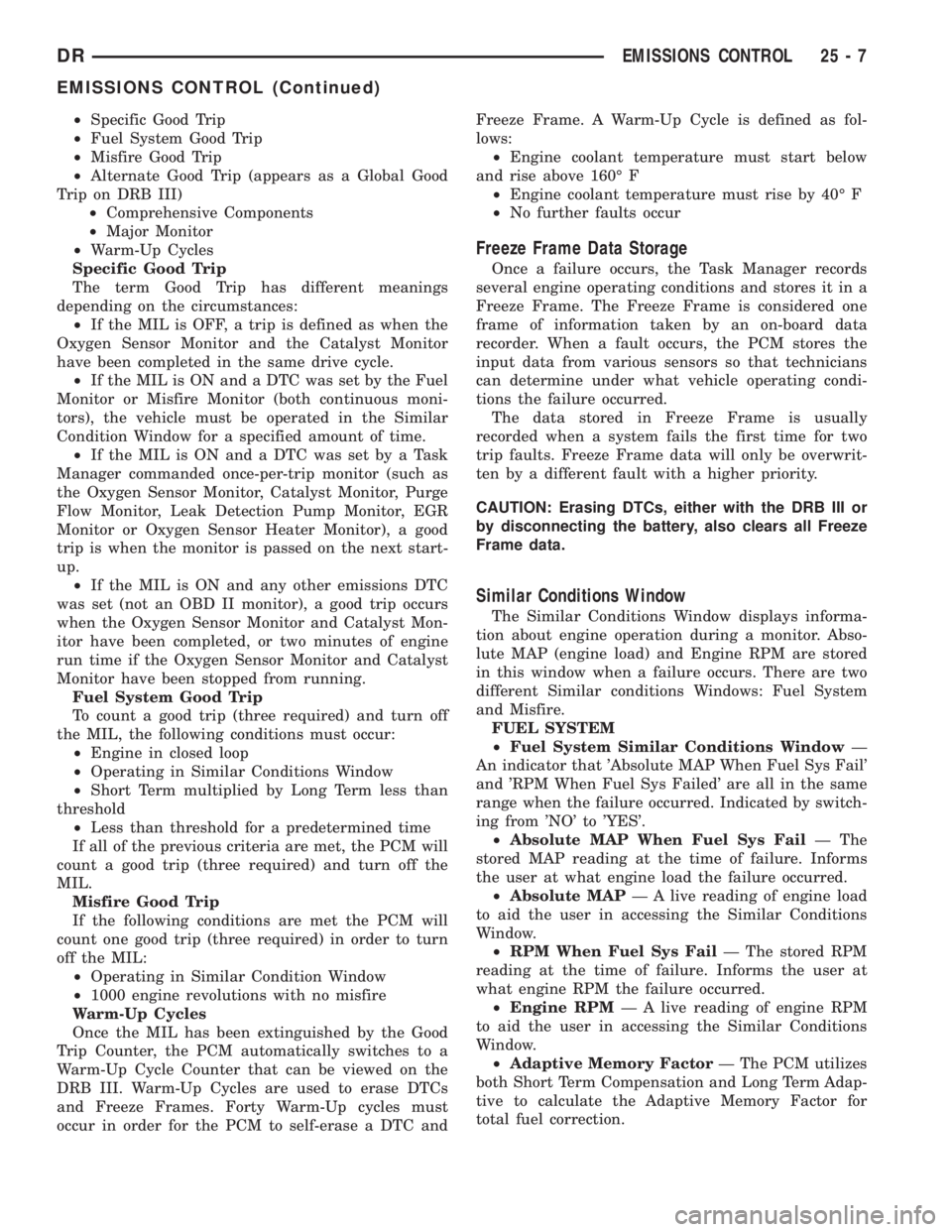
²Specific Good Trip
²Fuel System Good Trip
²Misfire Good Trip
²Alternate Good Trip (appears as a Global Good
Trip on DRB III)
²Comprehensive Components
²Major Monitor
²Warm-Up Cycles
Specific Good Trip
The term Good Trip has different meanings
depending on the circumstances:
²If the MIL is OFF, a trip is defined as when the
Oxygen Sensor Monitor and the Catalyst Monitor
have been completed in the same drive cycle.
²If the MIL is ON and a DTC was set by the Fuel
Monitor or Misfire Monitor (both continuous moni-
tors), the vehicle must be operated in the Similar
Condition Window for a specified amount of time.
²If the MIL is ON and a DTC was set by a Task
Manager commanded once-per-trip monitor (such as
the Oxygen Sensor Monitor, Catalyst Monitor, Purge
Flow Monitor, Leak Detection Pump Monitor, EGR
Monitor or Oxygen Sensor Heater Monitor), a good
trip is when the monitor is passed on the next start-
up.
²If the MIL is ON and any other emissions DTC
was set (not an OBD II monitor), a good trip occurs
when the Oxygen Sensor Monitor and Catalyst Mon-
itor have been completed, or two minutes of engine
run time if the Oxygen Sensor Monitor and Catalyst
Monitor have been stopped from running.
Fuel System Good Trip
To count a good trip (three required) and turn off
the MIL, the following conditions must occur:
²Engine in closed loop
²Operating in Similar Conditions Window
²Short Term multiplied by Long Term less than
threshold
²Less than threshold for a predetermined time
If all of the previous criteria are met, the PCM will
count a good trip (three required) and turn off the
MIL.
Misfire Good Trip
If the following conditions are met the PCM will
count one good trip (three required) in order to turn
off the MIL:
²Operating in Similar Condition Window
²1000 engine revolutions with no misfire
Warm-Up Cycles
Once the MIL has been extinguished by the Good
Trip Counter, the PCM automatically switches to a
Warm-Up Cycle Counter that can be viewed on the
DRB III. Warm-Up Cycles are used to erase DTCs
and Freeze Frames. Forty Warm-Up cycles must
occur in order for the PCM to self-erase a DTC andFreeze Frame. A Warm-Up Cycle is defined as fol-
lows:
²Engine coolant temperature must start below
and rise above 160É F
²Engine coolant temperature must rise by 40É F
²No further faults occur
Freeze Frame Data Storage
Once a failure occurs, the Task Manager records
several engine operating conditions and stores it in a
Freeze Frame. The Freeze Frame is considered one
frame of information taken by an on-board data
recorder. When a fault occurs, the PCM stores the
input data from various sensors so that technicians
can determine under what vehicle operating condi-
tions the failure occurred.
The data stored in Freeze Frame is usually
recorded when a system fails the first time for two
trip faults. Freeze Frame data will only be overwrit-
ten by a different fault with a higher priority.
CAUTION: Erasing DTCs, either with the DRB III or
by disconnecting the battery, also clears all Freeze
Frame data.
Similar Conditions Window
The Similar Conditions Window displays informa-
tion about engine operation during a monitor. Abso-
lute MAP (engine load) and Engine RPM are stored
in this window when a failure occurs. There are two
different Similar conditions Windows: Fuel System
and Misfire.
FUEL SYSTEM
²Fuel System Similar Conditions WindowÐ
An indicator that 'Absolute MAP When Fuel Sys Fail'
and 'RPM When Fuel Sys Failed' are all in the same
range when the failure occurred. Indicated by switch-
ing from 'NO' to 'YES'.
²Absolute MAP When Fuel Sys FailÐ The
stored MAP reading at the time of failure. Informs
the user at what engine load the failure occurred.
²Absolute MAPÐ A live reading of engine load
to aid the user in accessing the Similar Conditions
Window.
²RPM When Fuel Sys FailÐ The stored RPM
reading at the time of failure. Informs the user at
what engine RPM the failure occurred.
²Engine RPMÐ A live reading of engine RPM
to aid the user in accessing the Similar Conditions
Window.
²Adaptive Memory FactorÐ The PCM utilizes
both Short Term Compensation and Long Term Adap-
tive to calculate the Adaptive Memory Factor for
total fuel correction.
DREMISSIONS CONTROL 25 - 7
EMISSIONS CONTROL (Continued)
Page 2874 of 2895
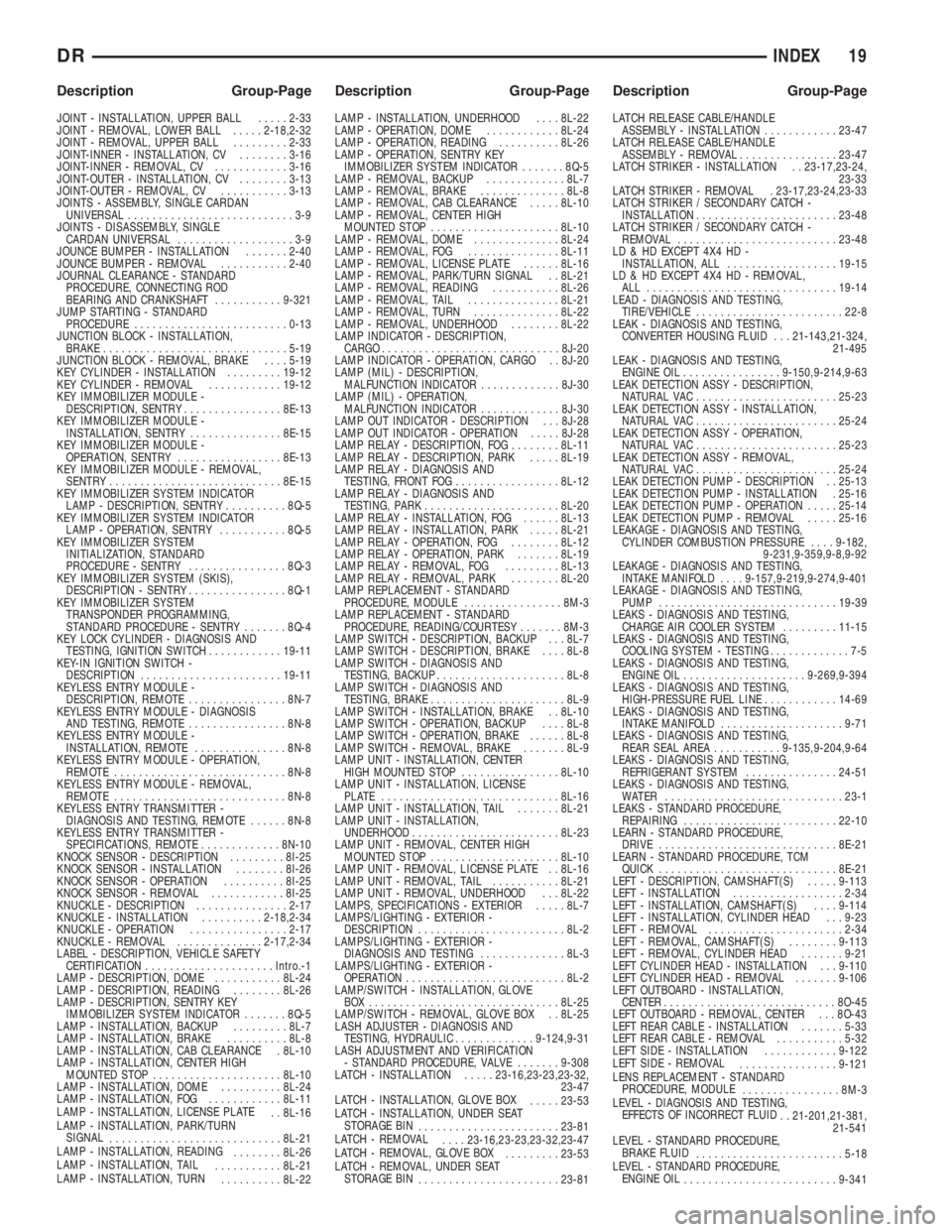
JOINT - INSTALLATION, UPPER BALL.....2-33
JOINT - REMOVAL, LOWER BALL.....2-18,2-32
JOINT - REMOVAL, UPPER BALL.........2-33
JOINT-INNER - INSTALLATION, CV........3-16
JOINT-INNER - REMOVAL, CV............3-16
JOINT-OUTER - INSTALLATION, CV........3-13
JOINT-OUTER - REMOVAL, CV...........3-13
JOINTS - ASSEMBLY, SINGLE CARDAN
UNIVERSAL...........................3-9
JOINTS - DISASSEMBLY, SINGLE
CARDAN UNIVERSAL...................3-9
JOUNCE BUMPER - INSTALLATION.......2-40
JOUNCE BUMPER - REMOVAL...........2-40
JOURNAL CLEARANCE - STANDARD
PROCEDURE, CONNECTING ROD
BEARING AND CRANKSHAFT...........9-321
JUMP STARTING - STANDARD
PROCEDURE.........................0-13
JUNCTION BLOCK - INSTALLATION,
BRAKE..............................5-19
JUNCTION BLOCK - REMOVAL, BRAKE....5-19
KEY CYLINDER - INSTALLATION.........19-12
KEY CYLINDER - REMOVAL............19-12
KEY IMMOBILIZER MODULE -
DESCRIPTION, SENTRY................8E-13
KEY IMMOBILIZER MODULE -
INSTALLATION, SENTRY...............8E-15
KEY IMMOBILIZER MODULE -
OPERATION, SENTRY.................8E-13
KEY IMMOBILIZER MODULE - REMOVAL,
SENTRY............................8E-15
KEY IMMOBILIZER SYSTEM INDICATOR
LAMP - DESCRIPTION, SENTRY..........8Q-5
KEY IMMOBILIZER SYSTEM INDICATOR
LAMP - OPERATION, SENTRY...........8Q-5
KEY IMMOBILIZER SYSTEM
INITIALIZATION, STANDARD
PROCEDURE - SENTRY................8Q-3
KEY IMMOBILIZER SYSTEM (SKIS),
DESCRIPTION - SENTRY................8Q-1
KEY IMMOBILIZER SYSTEM
TRANSPONDER PROGRAMMING,
STANDARD PROCEDURE - SENTRY.......8Q-4
KEY LOCK CYLINDER - DIAGNOSIS AND
TESTING, IGNITION SWITCH............19-11
KEY-IN IGNITION SWITCH -
DESCRIPTION.......................19-11
KEYLESS ENTRY MODULE -
DESCRIPTION, REMOTE................8N-7
KEYLESS ENTRY MODULE - DIAGNOSIS
AND TESTING, REMOTE................8N-8
KEYLESS ENTRY MODULE -
INSTALLATION, REMOTE...............8N-8
KEYLESS ENTRY MODULE - OPERATION,
REMOTE............................8N-8
KEYLESS ENTRY MODULE - REMOVAL,
REMOTE............................8N-8
KEYLESS ENTRY TRANSMITTER -
DIAGNOSIS AND TESTING, REMOTE......8N-8
KEYLESS ENTRY TRANSMITTER -
SPECIFICATIONS, REMOTE.............8N-10
KNOCK SENSOR - DESCRIPTION.........8I-25
KNOCK SENSOR - INSTALLATION........8I-26
KNOCK SENSOR - OPERATION..........8I-25
KNOCK SENSOR - REMOVAL............8I-25
KNUCKLE - DESCRIPTION...............2-17
KNUCKLE - INSTALLATION..........2-18,2-34
KNUCKLE - OPERATION................2-17
KNUCKLE - REMOVAL..............2-17,2-34
LABEL - DESCRIPTION, VEHICLE SAFETY
CERTIFICATION.....................Intro.-1
LAMP - DESCRIPTION, DOME...........8L-24
LAMP - DESCRIPTION, READING........8L-26
LAMP - DESCRIPTION, SENTRY KEY
IMMOBILIZER SYSTEM INDICATOR.......8Q-5
LAMP - INSTALLATION, BACKUP.........8L-7
LAMP - INSTALLATION, BRAKE..........8L-8
LAMP - INSTALLATION, CAB CLEARANCE . 8L-10
LAMP - INSTALLATION, CENTER HIGH
MOUNTED STOP.....................8L-10
LAMP - INSTALLATION, DOME..........8L-24
LAMP - INSTALLATION, FOG............8L-11
LAMP - INSTALLATION, LICENSE PLATE
. . 8L-16
LAMP - INSTALLATION, PARK/TURN
SIGNAL
............................8L-21
LAMP - INSTALLATION, READING
........8L-26
LAMP - INSTALLATION, TAIL
...........8L-21
LAMP - INSTALLATION, TURN
..........8L-22LAMP - INSTALLATION, UNDERHOOD....8L-22
LAMP - OPERATION, DOME............8L-24
LAMP - OPERATION, READING..........8L-26
LAMP - OPERATION, SENTRY KEY
IMMOBILIZER SYSTEM INDICATOR.......8Q-5
LAMP - REMOVAL, BACKUP.............8L-7
LAMP - REMOVAL, BRAKE..............8L-8
LAMP - REMOVAL, CAB CLEARANCE.....8L-10
LAMP - REMOVAL, CENTER HIGH
MOUNTED STOP.....................8L-10
LAMP - REMOVAL, DOME..............8L-24
LAMP - REMOVAL, FOG...............8L-11
LAMP - REMOVAL, LICENSE PLATE......8L-16
LAMP - REMOVAL, PARK/TURN SIGNAL . . 8L-21
LAMP - REMOVAL, READING...........8L-26
LAMP - REMOVAL, TAIL...............8L-21
LAMP - REMOVAL, TURN..............8L-22
LAMP - REMOVAL, UNDERHOOD........8L-22
LAMP INDICATOR - DESCRIPTION,
CARGO.............................8J-20
LAMP INDICATOR - OPERATION, CARGO . . 8J-20
LAMP (MIL) - DESCRIPTION,
MALFUNCTION INDICATOR.............8J-30
LAMP (MIL) - OPERATION,
MALFUNCTION INDICATOR.............8J-30
LAMP OUT INDICATOR - DESCRIPTION . . . 8J-28
LAMP OUT INDICATOR - OPERATION.....8J-28
LAMP RELAY - DESCRIPTION, FOG........8L-11
LAMP RELAY - DESCRIPTION, PARK.....8L-19
LAMP RELAY - DIAGNOSIS AND
TESTING, FRONT FOG.................8L-12
LAMP RELAY - DIAGNOSIS AND
TESTING, PARK......................8L-20
LAMP RELAY - INSTALLATION, FOG......8L-13
LAMP RELAY - INSTALLATION, PARK.....8L-21
LAMP RELAY - OPERATION, FOG........8L-12
LAMP RELAY - OPERATION, PARK.......8L-19
LAMP RELAY - REMOVAL, FOG.........8L-13
LAMP RELAY - REMOVAL, PARK........8L-20
LAMP REPLACEMENT - STANDARD
PROCEDURE, MODULE................8M-3
LAMP REPLACEMENT - STANDARD
PROCEDURE, READING/COURTESY.......8M-3
LAMP SWITCH - DESCRIPTION, BACKUP . . . 8L-7
LAMP SWITCH - DESCRIPTION, BRAKE....8L-8
LAMP SWITCH - DIAGNOSIS AND
TESTING, BACKUP.....................8L-8
LAMP SWITCH - DIAGNOSIS AND
TESTING, BRAKE......................8L-9
LAMP SWITCH - INSTALLATION, BRAKE . . 8L-10
LAMP SWITCH - OPERATION, BACKUP....8L-8
LAMP SWITCH - OPERATION, BRAKE......8L-8
LAMP SWITCH - REMOVAL, BRAKE.......8L-9
LAMP UNIT - INSTALLATION, CENTER
HIGH MOUNTED STOP................8L-10
LAMP UNIT - INSTALLATION, LICENSE
PLATE .............................8L-16
LAMP UNIT - INSTALLATION, TAIL.......8L-21
LAMP UNIT - INSTALLATION,
UNDERHOOD........................8L-23
LAMP UNIT - REMOVAL, CENTER HIGH
MOUNTED STOP.....................8L-10
LAMP UNIT - REMOVAL, LICENSE PLATE . . 8L-16
LAMP UNIT - REMOVAL, TAIL...........8L-21
LAMP UNIT - REMOVAL, UNDERHOOD . . . 8L-22
LAMPS, SPECIFICATIONS - EXTERIOR.....8L-7
LAMPS/LIGHTING - EXTERIOR -
DESCRIPTION........................8L-2
LAMPS/LIGHTING - EXTERIOR -
DIAGNOSIS AND TESTING..............8L-3
LAMPS/LIGHTING - EXTERIOR -
OPERATION..........................8L-2
LAMP/SWITCH - INSTALLATION, GLOVE
BOX ...............................8L-25
LAMP/SWITCH - REMOVAL, GLOVE BOX . . 8L-25
LASH ADJUSTER - DIAGNOSIS AND
TESTING, HYDRAULIC.............9-124,9-31
LASH ADJUSTMENT AND VERIFICATION
- STANDARD PROCEDURE, VALVE.......9-308
LATCH - INSTALLATION.....23-16,23-23,23-32,
23-47
LATCH - INSTALLATION, GLOVE BOX
.....23-53
LATCH - INSTALLATION, UNDER SEAT
STORAGE BIN
.......................23-81
LATCH - REMOVAL
....23-16,23-23,23-32,23-47
LATCH - REMOVAL, GLOVE BOX
.........23-53
LATCH - REMOVAL, UNDER SEAT
STORAGE BIN
.......................23-81LATCH RELEASE CABLE/HANDLE
ASSEMBLY - INSTALLATION............23-47
LATCH RELEASE CABLE/HANDLE
ASSEMBLY - REMOVAL................23-47
LATCH STRIKER - INSTALLATION . . 23-17,23-24,
23-33
LATCH STRIKER - REMOVAL . 23-17,23-24,23-33
LATCH STRIKER / SECONDARY CATCH -
INSTALLATION.......................23-48
LATCH STRIKER / SECONDARY CATCH -
REMOVAL..........................23-48
LD & HD EXCEPT 4X4 HD -
INSTALLATION, ALL..................19-15
LD & HD EXCEPT 4X4 HD - REMOVAL,
ALL ...............................19-14
LEAD - DIAGNOSIS AND TESTING,
TIRE/VEHICLE........................22-8
LEAK - DIAGNOSIS AND TESTING,
CONVERTER HOUSING FLUID . . . 21-143,21-324,
21-495
LEAK - DIAGNOSIS AND TESTING,
ENGINE OIL................9-150,9-214,9-63
LEAK DETECTION ASSY - DESCRIPTION,
NATURAL VAC.......................25-23
LEAK DETECTION ASSY - INSTALLATION,
NATURAL VAC.......................25-24
LEAK DETECTION ASSY - OPERATION,
NATURAL VAC.......................25-23
LEAK DETECTION ASSY - REMOVAL,
NATURAL VAC.......................25-24
LEAK DETECTION PUMP - DESCRIPTION . . 25-13
LEAK DETECTION PUMP - INSTALLATION . 25-16
LEAK DETECTION PUMP - OPERATION.....25-14
LEAK DETECTION PUMP - REMOVAL.....25-16
LEAKAGE - DIAGNOSIS AND TESTING,
CYLINDER COMBUSTION PRESSURE....9-182,
9-231,9-359,9-8,9-92
LEAKAGE - DIAGNOSIS AND TESTING,
INTAKE MANIFOLD....9-157,9-219,9-274,9-401
LEAKAGE - DIAGNOSIS AND TESTING,
PUMP.............................19-39
LEAKS - DIAGNOSIS AND TESTING,
CHARGE AIR COOLER SYSTEM.........11-15
LEAKS - DIAGNOSIS AND TESTING,
COOLING SYSTEM - TESTING.............7-5
LEAKS - DIAGNOSIS AND TESTING,
ENGINE OIL....................9-269,9-394
LEAKS - DIAGNOSIS AND TESTING,
HIGH-PRESSURE FUEL LINE............14-69
LEAKS - DIAGNOSIS AND TESTING,
INTAKE MANIFOLD....................9-71
LEAKS - DIAGNOSIS AND TESTING,
REAR SEAL AREA...........9-135,9-204,9-64
LEAKS - DIAGNOSIS AND TESTING,
REFRIGERANT SYSTEM...............24-51
LEAKS - DIAGNOSIS AND TESTING,
WATER .............................23-1
LEAKS - STANDARD PROCEDURE,
REPAIRING.........................22-10
LEARN - STANDARD PROCEDURE,
DRIVE.............................8E-21
LEARN - STANDARD PROCEDURE, TCM
QUICK.............................8E-21
LEFT - DESCRIPTION, CAMSHAFT(S).....9-113
LEFT - INSTALLATION..................2-34
LEFT - INSTALLATION, CAMSHAFT(S)....9-114
LEFT - INSTALLATION, CYLINDER HEAD . . . 9-23
LEFT - REMOVAL......................2-34
LEFT - REMOVAL, CAMSHAFT(S)........9-113
LEFT - REMOVAL, CYLINDER HEAD.......9-21
LEFT CYLINDER HEAD - INSTALLATION . . . 9-110
LEFT CYLINDER HEAD - REMOVAL.......9-106
LEFT OUTBOARD - INSTALLATION,
CENTER............................8O-45
LEFT OUTBOARD - REMOVAL, CENTER . . . 8O-43
LEFT REAR CABLE - INSTALLATION.......5-33
LEFT REAR CABLE - REMOVAL...........5-32
LEFT SIDE - INSTALLATION............9-122
LEFT SIDE - REMOVAL
................9-121
LENS REPLACEMENT - STANDARD
PROCEDURE, MODULE
................8M-3
LEVEL - DIAGNOSIS AND TESTING,
EFFECTS OF INCORRECT FLUID
. . 21-201,21-381,
21-541
LEVEL - STANDARD PROCEDURE,
BRAKE FLUID
........................5-18
LEVEL - STANDARD PROCEDURE,
ENGINE OIL
.........................9-341
DRINDEX 19
Description Group-Page Description Group-Page Description Group-Page
Page 2877 of 2895
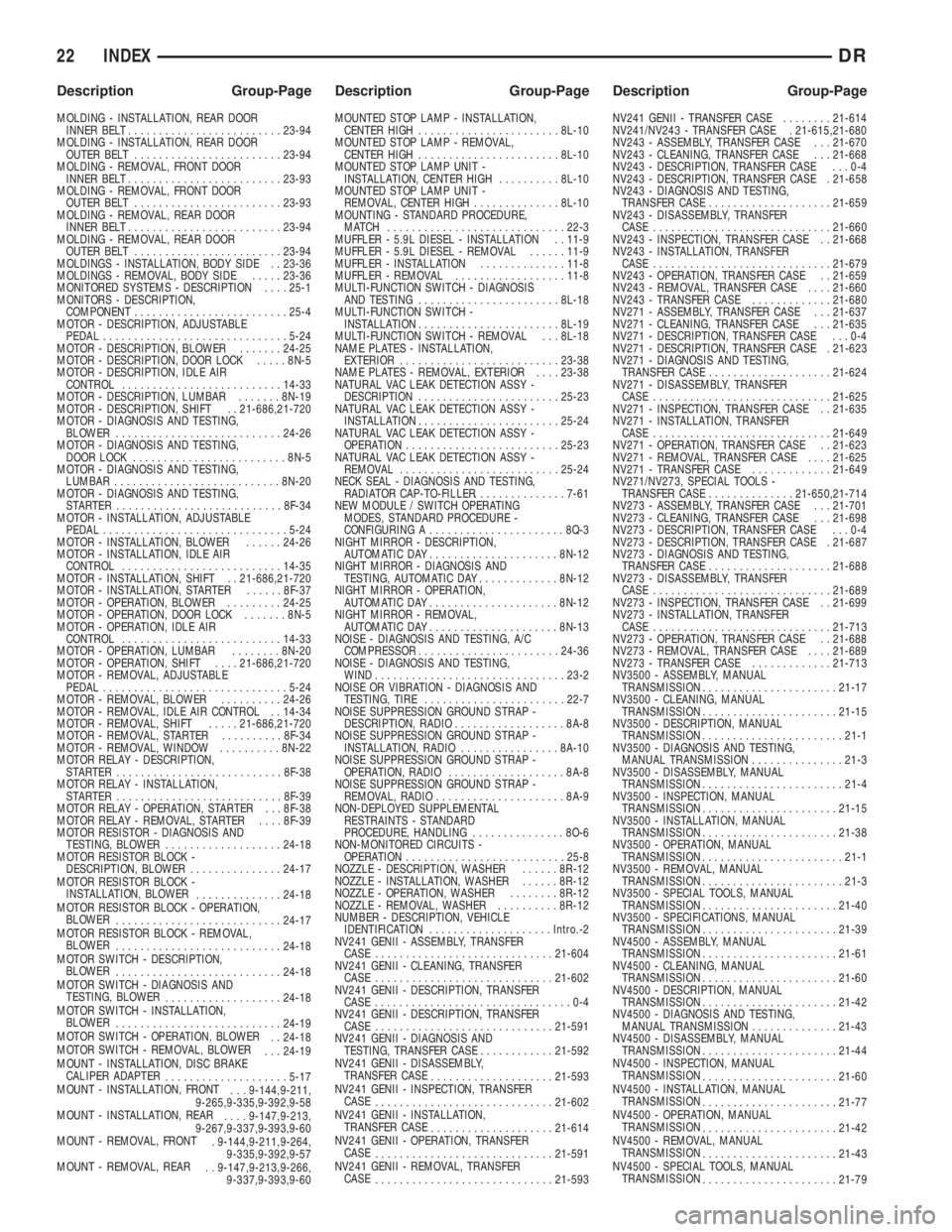
MOLDING - INSTALLATION, REAR DOOR
INNER BELT.........................23-94
MOLDING - INSTALLATION, REAR DOOR
OUTER BELT........................23-94
MOLDING - REMOVAL, FRONT DOOR
INNER BELT.........................23-93
MOLDING - REMOVAL, FRONT DOOR
OUTER BELT........................23-93
MOLDING - REMOVAL, REAR DOOR
INNER BELT.........................23-94
MOLDING - REMOVAL, REAR DOOR
OUTER BELT........................23-94
MOLDINGS - INSTALLATION, BODY SIDE . . 23-36
MOLDINGS - REMOVAL, BODY SIDE.....23-36
MONITORED SYSTEMS - DESCRIPTION....25-1
MONITORS - DESCRIPTION,
COMPONENT.........................25-4
MOTOR - DESCRIPTION, ADJUSTABLE
PEDAL..............................5-24
MOTOR - DESCRIPTION, BLOWER.......24-25
MOTOR - DESCRIPTION, DOOR LOCK.....8N-5
MOTOR - DESCRIPTION, IDLE AIR
CONTROL..........................14-33
MOTOR - DESCRIPTION, LUMBAR.......8N-19
MOTOR - DESCRIPTION, SHIFT . . 21-686,21-720
MOTOR - DIAGNOSIS AND TESTING,
BLOWER...........................24-26
MOTOR - DIAGNOSIS AND TESTING,
DOOR LOCK.........................8N-5
MOTOR - DIAGNOSIS AND TESTING,
LUMBAR...........................8N-20
MOTOR - DIAGNOSIS AND TESTING,
STARTER ...........................8F-34
MOTOR - INSTALLATION, ADJUSTABLE
PEDAL..............................5-24
MOTOR - INSTALLATION, BLOWER......24-26
MOTOR - INSTALLATION, IDLE AIR
CONTROL..........................14-35
MOTOR - INSTALLATION, SHIFT . . 21-686,21-720
MOTOR - INSTALLATION, STARTER......8F-37
MOTOR - OPERATION, BLOWER.........24-25
MOTOR - OPERATION, DOOR LOCK.......8N-5
MOTOR - OPERATION, IDLE AIR
CONTROL..........................14-33
MOTOR - OPERATION, LUMBAR........8N-20
MOTOR - OPERATION, SHIFT....21-686,21-720
MOTOR - REMOVAL, ADJUSTABLE
PEDAL..............................5-24
MOTOR - REMOVAL, BLOWER..........24-26
MOTOR - REMOVAL, IDLE AIR CONTROL . . 14-34
MOTOR - REMOVAL, SHIFT.....21-686,21-720
MOTOR - REMOVAL, STARTER..........8F-34
MOTOR - REMOVAL, WINDOW..........8N-22
MOTOR RELAY - DESCRIPTION,
STARTER ...........................8F-38
MOTOR RELAY - INSTALLATION,
STARTER ...........................8F-39
MOTOR RELAY - OPERATION, STARTER . . . 8F-38
MOTOR RELAY - REMOVAL, STARTER....8F-39
MOTOR RESISTOR - DIAGNOSIS AND
TESTING, BLOWER...................24-18
MOTOR RESISTOR BLOCK -
DESCRIPTION, BLOWER...............24-17
MOTOR RESISTOR BLOCK -
INSTALLATION, BLOWER
..............24-18
MOTOR RESISTOR BLOCK - OPERATION,
BLOWER
...........................24-17
MOTOR RESISTOR BLOCK - REMOVAL,
BLOWER
...........................24-18
MOTOR SWITCH - DESCRIPTION,
BLOWER
...........................24-18
MOTOR SWITCH - DIAGNOSIS AND
TESTING, BLOWER
...................24-18
MOTOR SWITCH - INSTALLATION,
BLOWER
...........................24-19
MOTOR SWITCH - OPERATION, BLOWER
. . 24-18
MOTOR SWITCH - REMOVAL, BLOWER
. . . 24-19
MOUNT - INSTALLATION, DISC BRAKE
CALIPER ADAPTER
....................5-17
MOUNT - INSTALLATION, FRONT
. . . 9-144,9-211,
9-265,9-335,9-392,9-58
MOUNT - INSTALLATION, REAR
....9-147,9-213,
9-267,9-337,9-393,9-60
MOUNT - REMOVAL, FRONT
. 9-144,9-211,9-264,
9-335,9-392,9-57
MOUNT - REMOVAL, REAR
. . 9-147,9-213,9-266,
9-337,9-393,9-60MOUNTED STOP LAMP - INSTALLATION,
CENTER HIGH.......................8L-10
MOUNTED STOP LAMP - REMOVAL,
CENTER HIGH.......................8L-10
MOUNTED STOP LAMP UNIT -
INSTALLATION, CENTER HIGH..........8L-10
MOUNTED STOP LAMP UNIT -
REMOVAL, CENTER HIGH..............8L-10
MOUNTING - STANDARD PROCEDURE,
MATCH .............................22-3
MUFFLER - 5.9L DIESEL - INSTALLATION . . 11-9
MUFFLER - 5.9L DIESEL - REMOVAL......11-9
MUFFLER - INSTALLATION..............11-8
MUFFLER - REMOVAL..................11-8
MULTI-FUNCTION SWITCH - DIAGNOSIS
AND TESTING.......................8L-18
MULTI-FUNCTION SWITCH -
INSTALLATION.......................8L-19
MULTI-FUNCTION SWITCH - REMOVAL . . . 8L-18
NAME PLATES - INSTALLATION,
EXTERIOR..........................23-38
NAME PLATES - REMOVAL, EXTERIOR....23-38
NATURAL VAC LEAK DETECTION ASSY -
DESCRIPTION.......................25-23
NATURAL VAC LEAK DETECTION ASSY -
INSTALLATION.......................25-24
NATURAL VAC LEAK DETECTION ASSY -
OPERATION.........................25-23
NATURAL VAC LEAK DETECTION ASSY -
REMOVAL..........................25-24
NECK SEAL - DIAGNOSIS AND TESTING,
RADIATOR CAP-TO-FILLER...............7-61
NEW MODULE / SWITCH OPERATING
MODES, STANDARD PROCEDURE -
CONFIGURING A......................8Q-3
NIGHT MIRROR - DESCRIPTION,
AUTOMATIC DAY.....................8N-12
NIGHT MIRROR - DIAGNOSIS AND
TESTING, AUTOMATIC DAY.............8N-12
NIGHT MIRROR - OPERATION,
AUTOMATIC DAY.....................8N-12
NIGHT MIRROR - REMOVAL,
AUTOMATIC DAY.....................8N-13
NOISE - DIAGNOSIS AND TESTING, A/C
COMPRESSOR.......................24-36
NOISE - DIAGNOSIS AND TESTING,
WIND...............................23-2
NOISE OR VIBRATION - DIAGNOSIS AND
TESTING, TIRE.......................22-7
NOISE SUPPRESSION GROUND STRAP -
DESCRIPTION, RADIO..................8A-8
NOISE SUPPRESSION GROUND STRAP -
INSTALLATION, RADIO................8A-10
NOISE SUPPRESSION GROUND STRAP -
OPERATION, RADIO...................8A-8
NOISE SUPPRESSION GROUND STRAP -
REMOVAL, RADIO.....................8A-9
NON-DEPLOYED SUPPLEMENTAL
RESTRAINTS - STANDARD
PROCEDURE, HANDLING...............8O-6
NON-MONITORED CIRCUITS -
OPERATION..........................25-8
NOZZLE - DESCRIPTION, WASHER......8R-12
NOZZLE - INSTALLATION, WASHER......8R-12
NOZZLE - OPERATION, WASHER........8R-12
NOZZLE - REMOVAL, WASHER..........8R-12
NUMBER - DESCRIPTION, VEHICLE
IDENTIFICATION....................Intro.-2
NV241 GENII - ASSEMBLY, TRANSFER
CASE.............................21-604
NV241 GENII - CLEANING, TRANSFER
CASE.............................21-602
NV241 GENII - DESCRIPTION, TRANSFER
CASE................................0-4
NV241 GENII - DESCRIPTION, TRANSFER
CASE.............................21-591
NV241 GENII - DIAGNOSIS AND
TESTING, TRANSFER CASE............21-592
NV241 GENII - DISASSEMBLY,
TRANSFER CASE
....................21-593
NV241 GENII - INSPECTION, TRANSFER
CASE
.............................21-602
NV241 GENII - INSTALLATION,
TRANSFER CASE
....................21-614
NV241 GENII - OPERATION, TRANSFER
CASE
.............................21-591
NV241 GENII - REMOVAL, TRANSFER
CASE
.............................21-593NV241 GENII - TRANSFER CASE........21-614
NV241/NV243 - TRANSFER CASE . 21-615,21-680
NV243 - ASSEMBLY, TRANSFER CASE . . . 21-670
NV243 - CLEANING, TRANSFER CASE . . . 21-668
NV243 - DESCRIPTION, TRANSFER CASE . . . 0-4
NV243 - DESCRIPTION, TRANSFER CASE . 21-658
NV243 - DIAGNOSIS AND TESTING,
TRANSFER CASE....................21-659
NV243 - DISASSEMBLY, TRANSFER
CASE.............................21-660
NV243 - INSPECTION, TRANSFER CASE . . 21-668
NV243 - INSTALLATION, TRANSFER
CASE.............................21-679
NV243 - OPERATION, TRANSFER CASE . . 21-659
NV243 - REMOVAL, TRANSFER CASE....21-660
NV243 - TRANSFER CASE.............21-680
NV271 - ASSEMBLY, TRANSFER CASE . . . 21-637
NV271 - CLEANING, TRANSFER CASE . . . 21-635
NV271 - DESCRIPTION, TRANSFER CASE . . . 0-4
NV271 - DESCRIPTION, TRANSFER CASE . 21-623
NV271 - DIAGNOSIS AND TESTING,
TRANSFER CASE....................21-624
NV271 - DISASSEMBLY, TRANSFER
CASE.............................21-625
NV271 - INSPECTION, TRANSFER CASE . . 21-635
NV271 - INSTALLATION, TRANSFER
CASE.............................21-649
NV271 - OPERATION, TRANSFER CASE . . 21-623
NV271 - REMOVAL, TRANSFER CASE....21-625
NV271 - TRANSFER CASE.............21-649
NV271/NV273, SPECIAL TOOLS -
TRANSFER CASE..............21-650,21-714
NV273 - ASSEMBLY, TRANSFER CASE . . . 21-701
NV273 - CLEANING, TRANSFER CASE . . . 21-698
NV273 - DESCRIPTION, TRANSFER CASE . . . 0-4
NV273 - DESCRIPTION, TRANSFER CASE . 21-687
NV273 - DIAGNOSIS AND TESTING,
TRANSFER CASE....................21-688
NV273 - DISASSEMBLY, TRANSFER
CASE.............................21-689
NV273 - INSPECTION, TRANSFER CASE . . 21-699
NV273 - INSTALLATION, TRANSFER
CASE.............................21-713
NV273 - OPERATION, TRANSFER CASE . . 21-688
NV273 - REMOVAL, TRANSFER CASE....21-689
NV273 - TRANSFER CASE.............21-713
NV3500 - ASSEMBLY, MANUAL
TRANSMISSION......................21-17
NV3500 - CLEANING, MANUAL
TRANSMISSION......................21-15
NV3500 - DESCRIPTION, MANUAL
TRANSMISSION.......................21-1
NV3500 - DIAGNOSIS AND TESTING,
MANUAL TRANSMISSION...............21-3
NV3500 - DISASSEMBLY, MANUAL
TRANSMISSION.......................21-4
NV3500 - INSPECTION, MANUAL
TRANSMISSION......................21-15
NV3500 - INSTALLATION, MANUAL
TRANSMISSION......................21-38
NV3500 - OPERATION, MANUAL
TRANSMISSION.......................21-1
NV3500 - REMOVAL, MANUAL
TRANSMISSION.......................21-3
NV3500 - SPECIAL TOOLS, MANUAL
TRANSMISSION......................21-40
NV3500 - SPECIFICATIONS, MANUAL
TRANSMISSION......................21-39
NV4500 - ASSEMBLY, MANUAL
TRANSMISSION......................21-61
NV4500 - CLEANING, MANUAL
TRANSMISSION......................21-60
NV4500 - DESCRIPTION, MANUAL
TRANSMISSION......................21-42
NV4500 - DIAGNOSIS AND TESTING,
MANUAL TRANSMISSION..............21-43
NV4500 - DISASSEMBLY, MANUAL
TRANSMISSION......................21-44
NV4500 - INSPECTION, MANUAL
TRANSMISSION
......................21-60
NV4500 - INSTALLATION, MANUAL
TRANSMISSION
......................21-77
NV4500 - OPERATION, MANUAL
TRANSMISSION
......................21-42
NV4500 - REMOVAL, MANUAL
TRANSMISSION
......................21-43
NV4500 - SPECIAL TOOLS, MANUAL
TRANSMISSION
......................21-79
22 INDEXDR
Description Group-Page Description Group-Page Description Group-Page